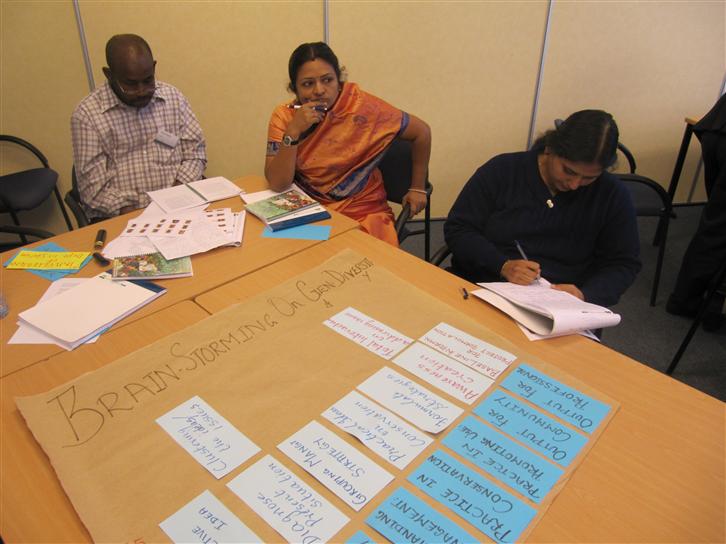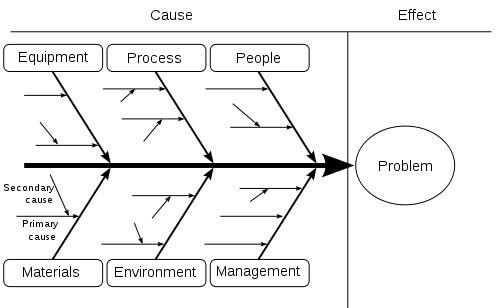Four Creative Thinking Methods
Generation Method – Card Brainstorming

Rules: Delay judgment, impose no limits, generate as many as ideas as possible, take a broad view, joint development
Step 1: Everyone prepares post-it notes, pen and A4 paper. Place 3 ~ 4 sheets of A3 paper in the middle of the meeting.
Step 2: Define the theme to brainstorm.
Step 3: Set 5 minutes as the brainstorming time. Within this period, have everyone write all of their ideas on post-it notes and stick them to their A4 paper.
Step 4: After 5 minutes, have everyone present the ideas they wrote on the post-it notes. Read post-it notes are then stuck to the A3 paper in the middle of the meeting.
Step 5: Look at all the ideas on the A3 paper in the middle while listening to other people express their thoughts. If a new idea strikes you, write it on a post-it note and stick it to your piece of A4 paper to be presented later.
Step 6: If someone has nothing to add then they can pass. If more than two people pass however then hold a 5-minute brainstorming session. After 5 minutes, start again from the people that passed.
Step 7: The process can finish after 1 hour. If there are any post-it notes that have not yet been presented then place them on the A3 paper in the middle.
Generation Method – Mandala

No. of People: 1
Step 1: Draw a 3×3 square and write the topic in the middle.
Step 2: Write all of your ideas and thoughts inspired by the topic in the surrounding 8 squares.
Step 3: Once all of the squares have been filled, pick any idea in one of the surrounding 8 squares then expand it into a new 3×3 square.
Convergence Method – Block Technique
Step 1: Collect the post-it notes written with ideas from the CBS method.
Step 2: Organize the ideas on the cards/post-it notes into different blocks.
Step 3: Define a title for each block.
Convergence Method – Fish Bone

Step 1: Define the topic then write it on the right hand side where the fish head is.
Step 2: Use CBS to find the reasons for the problem. Primary causes should be written where the ribs are with secondary causes branching off the ribs.
Step 3: Stick all of the post-it notes on to the fish bone graph then analyze the fish bone to identify the main causes.
Step 4: Use the fish bone graph to find the cause of the problem. Next, identify the most important causes and develop a solution.
Five Tools for Creative Thinking
Advantage: Portable, reusable, easy to organize and doesn't have to be copied down.
Disadvantage: Can't be used in situations where you can't hold a pen and can't be saved to a computer.
Advantage: Can be used anywhere and at any time, and can save information to computer.
Disadvantage: Must write down your thoughts yourself, battery may run out .
Creativity Tool 3—Digital CameraPurpose: Some ideas aren't easy to write down. A digital camera can be used to capture an image as a source for inspiration.
Advantage: An image-inspired idea is more persuasive, data can be saved to computer, can be incorporated into a webpage or proposal.
Disadvantage: It's inconvenient converting image into text, battery may run out .
Creativity Tool 4 – Mobile PhonePurpose: Mobile phones today come with an increasing number of functions such as communications, Internet access, camera, sound recording… They can do practically everything that the other tools do. There are even post-it note apps available for download online. Just carry a multi-purpose mobile phone and most creativity tools will be at your finger tips.
Disadvantage:Battery may run out.
Purpose:The computer is the most power tool for generating ideas. It can be used to collect, store and create information. We can go online to collect data, store the data on the computer then use them to produce presentations or documents. Voice recordings, photos and text must all be uploaded to the computer for processing in the end so the computer is the "Treasure House of Creativity".
Advantage: Can collect, store and create information.
Disadvantage: Not portable and can't be used to record ideas at any time and in any place.
